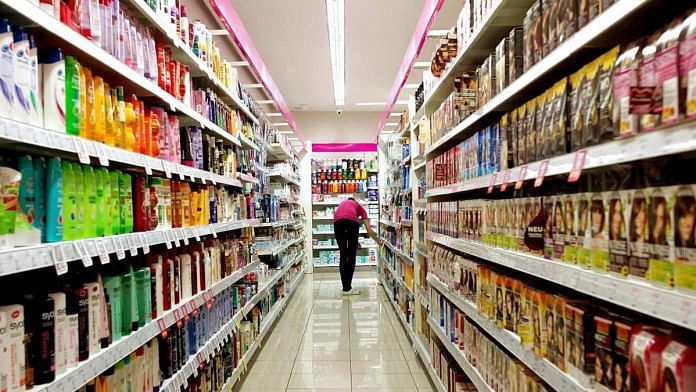The festive season will be a little less sparkly, as British retailers including Morrisons, Waitrose and John Lewis are removing glitter from their Christmas ranges to cut down on microplastics.
Supermarket chain Morrisons said they would be removing 50 tonnes of plastic from shelves this festive season, including no longer using plastic toys in crackers and reducing single-use plastic packaging on cards and decorations.
“Every time a cracker is pulled, or a card is opened, plastics have been used… but just the once,” said Christine Bryce, Morrisons Home Director. “We’ve taken glitter and plastic out of our festive range this year – so that our customers can enjoy their festivities without worrying about the environmental impact.”
Other British retailers including Marks & Spencer, Sainsbury’s and Asda and Boots have already announced similar moves.
Also read: Banning glitter is not going to save the oceans
What are microplastics?
Microplastics are very small pieces of plastic, typically smaller than 5mm, that pollute the environment. They accumulate in animals, including fish and shellfish, and can harm the fertility, growth and survival of marine life and other species.
Small microplastic particles can be eaten by zooplankton, tiny marine animals which underpin the marine food chain and play an important role in regulating the global climate.
Humans can also consume or inhale microplastics. The impact on human health is largely unknown and the subject of continuing research. Scientists are concerned that microplastics may carry pathogens or toxic chemicals into the body.
How many are there?
The world produces 380 million tonnes of plastics which can pollute our oceans and environment, according to Our World In Data.
A study led by Plymouth Marine Laboratory, found concentrations of coastal microplastics could be up to 10 times greater than previously thought.
“Microplastic concentrations could exceed 3,700 microplastics per cubic metre,” the scientists say – adding that this would be far more than the number of zooplankton.
Most of the microplastics identified in the study were fibres, from sources likely to include synthetic clothing and textiles, fishing gear and vehicle tyres.
A better understanding of where microplastics in the marine environment come from could “help influence societal behaviour and drive future policy intervention,” the authors say.
Also read: These are the markets of tomorrow — hyperloops, edtech, e-vehicles and reskilling
Global action
Efforts are underway globally to tackle plastic pollution, including microplastics.
In the last two years, the USA, Canada, New Zealand, Sweden, France and England and Scotland have all introduced a ban on the manufacture and sale of certain personal care treatment products containing plastic microbeads.
In Europe, the cosmetics industry started voluntarily phasing out plastic microbeads in exfoliating ‘rinse-off’ products such as facial or body scrubs in 2012. This had led to a 97.6% decrease in their use by 2018, according to trade association Cosmetics Europe.
The European Union is consulting on a proposed ban of intentionally added microplastics to any consumer or professional products. The aim is to cut microplastic pollution by at least 70% and prevent the release of 500,000 tonnes of microplastics over the 20 years following the ban’s introduction.
Circular solutions
Governments, businesses and communities globally are exploring better production, recycling and reuse systems. These aim to create a sustainable, circular economy in plastic and tackle problematic plastics like throwaway single-use packaging.
In 2018, the Global Plastic Action Partnership (GPAP) was launched at the World Economic Forum’s Sustainable Development Impact Summit to drive action on plastic pollution.
Its core vision is to replace the “take-use-dispose” model of plastic use with a more sustainable and circular “reduce-redesign-reuse” system.
The Forum is also a supporter of the New Plastics Economy, led by circular economy charity the Ellen MacArthur Foundation.
In July, The Pew Charitable Trusts and SYSTEMIQ released Breaking the Plastic Wave: A Comprehensive Assessment of Pathways Towards Stopping Ocean Plastic Pollution.
It found that unless action was taken, the volume of plastic on the market would double by 2040, and the annual volume of plastic entering the ocean would almost triple, from 11 million tonnes in 2016 to 29 million tonnes in 2040.
A circular economy has the potential to reduce the volume of plastics entering our oceans each year by 80%, compared to the business-as-usual scenario. It could also generate savings of $200 billion per year, reduce greenhouse gas emissions by 25%, and create 700,000 net additional jobs by 2040.
The vision of the New Plastics Economy includes eliminating all problematic and unnecessary plastic items and innovating to ensure the plastics we do need are reusable, recyclable, or compostable.
Another initiative launched by the World Economic Forum in 2018 is the Platform for Accelerating the Circular Economy (PACE). It is now hosted by the World Resources Institute and is a global community of leaders working together to accelerate the transition to a circular economy.
This article was first published in the World Economic Forum.
Also read: Contaminated waste — the epidemic the world is struggling with thanks to Covid-19






